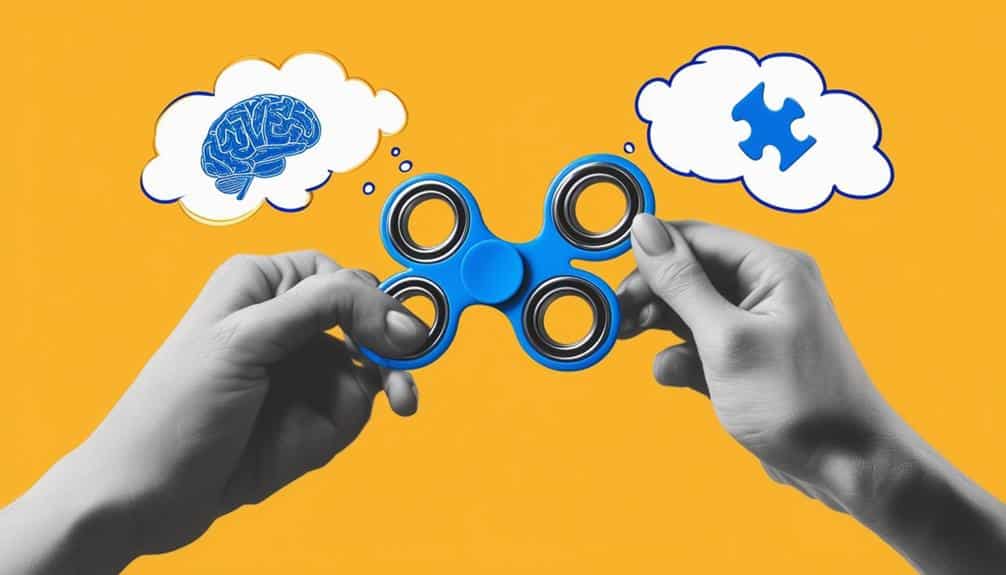Stimming, an abbreviation for self-stimulating behavior, is a term that encompasses a broad range of repetitive actions or noises engaged in by individuals as a coping mechanism for various feelings or sensory experiences. Notably prevalent in conditions such as Autism and ADHD, stimming can take many forms, including auditory, vocal, tactile, visual, or vestibular. This self-regulation tool can help manage feelings, control sensory input, alleviate boredom, and improve concentration. Yet, understanding the triggers and responses to stimming, essential for crafting adequate support and management strategies, remains elusive and warrants further exploration.
Key Takeaways
- Stimming is a self-stimulating behavior involving repetitive actions or sounds.
- It serves as a coping mechanism to manage feelings and sensory experiences.
- Stimming can take various forms, including auditory, vocal, tactile, visual, or vestibular.
- In Autism and ADHD, stimming helps regulate emotions and sensory input or improve focus.
Understanding Stimming
Stimming, an abbreviation for self-stimulating behaviors, is a complex coping mechanism characterized by repetitive actions or sounds that specifically help people with conditions such as autism and ADHD manage their feelings and navigate sensory experiences. Autistic people, for instance, often engage in repetitive body movements – an essential type of stimming. These behaviors can be auditory, vocal, tactile, visual, or vestibular, ranging from twirling hair to tapping fingers.
Essentially, stimming serves as a self-regulation strategy. It provides a means for individuals to manage overwhelming situations and intense sensory experiences that might otherwise be too distressing. It’s an innate response that offers comfort and control when the external environment becomes too much to bear.
However, understanding these triggers and responses is essential for managing stimming behaviors effectively. This understanding allows for developing strategies that respect the person’s need for self-regulation and guarantee safety, especially when harmful stims, such as head-banging, may be present.
Therefore, while stimming can be beneficial for mental health and emotional processing, it’s essential to be mindful of its potential risks and manage them accordingly.
Stimming in Autism and ADHD
Stimming, while an expected behavior amongst individuals with Autism and ADHD, serves unique functions in each scenario. For those with Autism, stimming often serves as a self-regulatory behavior in response to heightened sensory stimuli, evidenced in behaviors like repetitive finger shaking.
Conversely, in ADHD, stimming may help manage intense feelings, alleviate boredom, and improve focus, necessitating a nuanced understanding of these behaviors for effective management and support.
Understanding Autism Stimming
While it’s observed that people with autism and ADHD frequently engage in stimming, a self-stimulating behavior, it’s essential to understand that this activity helps these persons regulate emotions, manage sensory input, alleviate boredom, and improve focus. Specifically, in the autism spectrum, self-stimulatory behaviors act as coping mechanisms when dealing with overwhelming sensory inputs or emotions.
Triggers and responses to stimming can be distinct to each person and reflect their specific needs and sensory responses. For instance, an autistic person may rock back and forth to soothe themselves during stressful situations, while others may flap their hands when excited.
To better understand and appreciate the role of stimming in autism and ADHD, consider the following table:
| Autism | ADHD |
|---|---|
| Regulates emotions | Manages emotions |
| Manages sensory input | Alleviates boredom |
| It can be used to communicate needs or emotions | Improves focus |
| Reflects individual needs and sensory responses | Reflects individual needs and sensory responses |
Understanding these behaviors and their triggers can pave the way for better support strategies, fostering an environment that encourages their growth and development.
ADHD and Stimming Relationship
Delving deeper into the connection between ADHD and stimming, it becomes evident that these self-stimulatory behaviors serve as vital coping mechanisms, aiding people in managing emotions, combating boredom, and augmenting focus. Stimming behaviors in those with ADHD can manifest differently than in individuals with autism, making recognition and understanding essential.
The intensity and frequency of stimming can vary significantly among persons with ADHD. Recognizing these fluctuations can provide valuable insights into those affected’s emotional and cognitive states. It’s important to empathize with the reality of living with ADHD, where stimming behaviors often play a significant role in navigating daily life.
Understanding the triggers and responses associated with these behaviors is fundamental in managing ADHD-related stimming. By recognizing the purpose of stimming, caregivers and professionals can devise effective strategies for managing it. This contributes to individuals’ well-being and supports their ability to function optimally in their environments.
The ADHD-stimming relationship is complex, requiring a delicate balance of understanding, patience, and targeted intervention. As those serving this community, we must deepen our understanding of this relationship and apply it in the most effective and compassionate ways possible.
Differentiating Autism and ADHD Stimming
Building on our exploration of stimming in ADHD, it’s necessary to analyze how stimming manifests in autism and to understand the critical differences between these two conditions.
Stimming, or self-stimulatory behavior, in autism often responds to heightened sensory experiences. This can include repetitive behaviors such as finger shaking, which is an automated mechanism.
On the other hand, in ADHD, stimming is a method of managing emotions, alleviating boredom, or enhancing focus. This difference in purpose is a fundamental distinguishing factor between stimming in autism and ADHD.
While the behaviors may appear similar, understanding their motivations is essential for effectively managing them.
Understanding the triggers and responses can help devise strategies to manage stimming behaviors in both conditions. It’s important to remember that these behaviors serve a purpose for the individuals involved, and the goal should be to minimize any negative impact without eliminating a coping mechanism.
Recognizing and understanding these differences is a step towards providing more empathetic and practical support for those with ADHD or autism.
Benefits and Risks of Stimming

In exploring the nuances of stimming, it’s important to understand that this behavior serves as an essential tool for self-regulation, mental health support, and psychological processing.
As an outlet for overwhelming emotions, stimming can provide a much-needed release, whether those emotions are positive or negative. However, while many stims are harmless and even beneficial, it’s essential to be aware that some, known as harmful stims, can lead to health consequences and social repercussions.
For instance, behaviors such as head-banging, a form of harmful stim, can pose a physical risk to the person. Moreover, harmful stims can lead to social isolation, as they may not be well-understood or accepted by others. Thus, understanding the potential risks associated with stimming is vital for anyone seeking to support people who engage in this behavior.
However, it’s equally essential to recognize the benefits of stimming. When managed effectively, this behavior can contribute significantly to an individual’s mental well-being, helping them feel in control of their psychological state. Acceptance and positive management of stimming behaviors are crucial to promoting overall well-being.
Managing Well-being: Effective Strategies for Stimming Behaviors
Understanding the benefits and potential risks of stimming is crucial. Now, let’s shift our focus to strategies for managing these behaviors in a supportive and effective way. Recognizing the triggers and responses that lead to stimming behaviors is the first step in managing them. This knowledge can help devise strategies to reduce these behaviors without distressing the individual.
Implementing routines, clear expectations, and structured environments can significantly mitigate stimming. Such environments provide predictability and security, which can help minimize anxiety-driven stimming.
Acceptance is another critical factor. Learning to cope with these behaviors positively can be more effective than suppressing them. Stimming toys like chewing or calming objects can provide soothing movements and reduce stimming behaviors.
Lastly, it’s essential to seek professional help when needed. Board-certified behavior Analysts (BCBA), Occupational Therapists (OT), or Speech-Language Pathologists (SLP) can provide coaching and replacement teaching to address stimming behaviors. Their guidance can be invaluable in navigating this complex journey.
Managing stimming is about understanding, acceptance, and structured support.
Additional Information on Autism

To fully comprehend the intricacies of stimming, it’s essential to explore the broader context in which it often occurs: autism. This developmental disorder significantly impacts social skills and is typified by communication difficulties and repetitive movements.
Autism is a spectrum condition, meaning its symptoms and their severity vary greatly from person to person—these range from mild social interaction difficulties and limited interests to significant communication challenges and sensory overload.
Early intervention is vital to maximizing potential and improving the quality of life for those on the autism spectrum. Recognized treatment modalities such as Applied Behavior Analysis (ABA) and speech therapy can address these challenges, providing better communication and behavior management tools.
Understanding these complexities of autism is fundamental for anyone seeking to serve this distinct population. Dispelling myths about autism and promoting acceptance and inclusion is also vital to creating a supportive environment.
This knowledge can help tailor interventions, fostering better outcomes for individuals with autism. Remember, every person with autism is exceptional; understanding their needs and potential is the first step in providing adequate support.
Professional Help for Stimming
How can professional assistance be leveraged to manage stimming behaviors effectively?
When faced with harmful stimming behaviors, professional help can be an essential resource. Experts like Board Certified Behavior Analysts (BCBA), Occupational Therapists (OT), or Speech-Language Pathologists (SLP) can provide effective coaching and teaching alternatives for managing stimming behaviors.
These professionals can:
- Raise awareness around personal stimming patterns, paving the way to identify and replace harmful habits with safer alternatives.
- Encourage regular breaks during tasks or activities, allowing individuals to engage in stimming practices in a safe and controlled manner.
- Utilize shaping techniques, gradually steering the person away from harmful stimming actions and towards more positive behaviors.
- Collaborate with caregivers and educators to create a supportive environment, fostering positive coping mechanisms and reducing the frequency of negative stimming behaviors.
With professional guidance, individuals who stim can learn to manage their behaviors in a way that supports their well-being and promotes lifestyle.
Mental Well-being

As we continue our exploration of stimming, it’s essential to broaden our understanding of related mental health conditions that can manifest this behavior. Specifically, we will discuss Narcissistic Individual Disorder and the dynamics of medication holidays in Attention Deficit Hyperactivity Disorder (ADHD).
These discussions aim to illuminate the complexities of these mental health issues and the role stimming may play within them.
Understanding Narcissistic Personality
In the field of mental health, Narcissistic Personality Disorder is characterized by a distinct pattern of grandiosity, a pervasive need for admiration, and a significant lack of empathy for others. This disorder often manifests in behaviors that reflect a sense of entitlement and a constant craving for excessive admiration.
Understanding Narcissistic Personality Disorder is essential in the mental health field because:
- It is a recognized mental health condition with specific diagnostic criteria.
- Individuals with this disorder often have problematic interpersonal relationships due to their behavior and lack of empathy.
- The severity of narcissistic traits can vary, influencing the impact on social interactions and personal relationships.
- Therapy and counseling can assist individuals to develop healthier coping mechanisms and improve their relationships.
Understanding and addressing Narcissistic Personality Disorder requires empathy, patience, and specialized knowledge.
As those serving others, it is our duty to be informed about this disorder so that we can provide adequate support and contribute to the overall well-being of the affected individuals. By aiming for a thorough understanding, we can better serve our community.
Medication Holidays for ADHD
Exploring the complexities of Attention Deficit Hyperactivity Disorder (ADHD) treatment, one may encounter the concept of ‘medication holidays,’ a strategic cessation of medication to evaluate its ongoing effectiveness and necessity. This practice is often employed to assess whether the prescribed drug is still required or if alterations in dosage or overall treatment approach are warranted.
The decision to implement a medication holiday should not be undertaken lightly. Patients with ADHD often struggle with overwhelming sensory input and self-stimulating behaviors, which can be exacerbated in the absence of proper medication. Hence, a medical professional’s supervision is vital during this period to guarantee the patient’s safety.
A well-planned medication holiday can offer several benefits, including reducing tolerance to the drug and minimizing potential side effects. However, it also carries risks such as potential resurgence of symptoms, decreased concentration, and challenges in daily functioning. Therefore, it is crucial to weigh these factors carefully.
Ultimately, the goal of a medication holiday in ADHD treatment is to provide the best possible care for the patient. This approach reinforces the importance of ongoing assessment and individualized care in managing complex conditions like ADHD.
Trending Health Topics
While there are myriad health topics currently trending, two areas of specific interest include advancements in diabetes and endocrinology—specifically, the exploration of methods to increase metabolism for weight loss and the health implications of PFAS and Forever Chemicals—as well as emerging trends in skincare and beauty, such as the use of rice water for healthier hair and strategies for aging well. These cutting-edge subjects cater to a broad audience, including those with an interest in serving people with autism, who often exhibit distinct behaviors such as stimming.
The following points further delve into these topics:
- Innovative strategies to enhance metabolic rate are being researched, potentially benefiting those struggling with weight loss, including some individuals with autism who may struggle with weight due to medication side effects.
- The health impact of PFAS and Forever Chemicals, pervasive in our environment, is a rising concern, particularly for their potential role in endocrine disruption.
- Rice water’s efficacy in promoting healthier, stronger hair is being explored as a natural and cost-effective alternative to commercially available hair care products.
- Aging well is not just about longevity but also about maintaining quality of life and independence.
Definition and Theories of Stimming

Stimming, short for self-stimulating behaviors, typically refers to specific, repetitive actions and movements, such as hand-flapping or body-rocking, often observed in people with autism spectrum disorder.
Depending on the person’s specific needs and circumstances, these behaviors serve various purposes, including self-regulation and sensory reinforcement.
Theories behind stimming suggest that various factors, including a need for endorphin production or a response to overwhelming sensory input, may drive these behaviors.
Understanding Stimming Behaviors
To fully appreciate the complexity of stimming behaviors, it is crucial to explore their definition and the various theories that attempt to explain their occurrence, particularly in people on the autism spectrum. Stimming, or self-stimulating behaviors, involve repetitive body movements or sounds. It often serves as a coping mechanism for managing overwhelming sensory information, and people on the autism spectrum frequently engage in stimming.
Understanding stimming behaviors requires recognizing these facts:
- Stimming can vary widely, from hand flapping and rocking to subtler actions like tapping or twirling.
- Stimming may serve vital functions such as emotional regulation or sensory reinforcement.
- Some theories suggest stimming increases endorphin production, which can create feelings of comfort.
- Knowledge of why individuals engage in stimming is crucial before attempting any intervention.
Theories Behind Stimming
To delve further into the field of stimming, it’s essential to ponder the different theories that have been put forward to elucidate this intriguing behavior, mainly as it appears in individuals on the autism spectrum. One well-regarded theory suggests that these repetitive body movements are a self-soothing mechanism, providing sensory reinforcement and a means to regulate overwhelming stimuli. For example, the rhythmic rocking or the tactile sensation of hand flapping may offer a sense of control and predictability in a chaotic world.
Another insightful theory posits that stimming could stimulate endorphin production as a physiological reward. These behaviors, regardless of how they manifest, from full body motions to more isolated actions, are thought to provide a comforting sensation akin to the feeling one gets from a deep pressure massage or a tight hug.
However, it’s essential to acknowledge that some stims, like head banging, can be disruptive or potentially harmful. As we continue to explore the domain of stimming, our understanding will ideally lead to strategies that can guarantee the safety and comfort of those who engage in these behaviors.
Prevalence and Types of Stimming
Stimulating—or self-stimulating behaviors—are broadly observed in both neurotypical people and those with autism. They encompass a broad spectrum of actions, ranging from subtle, repetitive movements to more pronounced full-body motions. This prevalence underscores the fundamental need for sensory feedback, which people use stimming to fulfill.
Among the varied types of stimming, some are universally recognized, while others can be pretty distinct to the person. A few commonly observed stims include:
- Hand flapping: A rapid motion of the hands, often seen when a person is excited or anxious.
- Staring at rotating objects: A fascination with circular movements, from ceiling fans to spinning tops.
- Vocalizations may include humming, grunting, or repeating certain words or phrases.
- Head banging: A more intense form of stimming, often associated with frustration or distress.
While the above examples give a glimpse into the world of stimming, it is essential to note that this behavior is highly personalized, necessitating a nuanced understanding among those desiring to serve this population.
Impact of Stimming on Individuals

While the manifestation of stimming behaviors varies significantly among people, it is undeniable that these practices can profoundly affect a person’s ability to learn and perform tasks, especially when they become disruptive or pose potential harm. The impact on individuals can range from minor distractions to significant impediments in daily functioning.
For instance, an individual who repetitively taps a pencil on a desk may find it calming, but it could distract others in a classroom or office setting. In more severe cases, harmful stimming behaviors, such as self-hitting or head-banging, can lead to physical injury.
Not all individuals on the autism spectrum engage in disruptive or harmful stimming, and it’s important to note that stimming may serve various functions across different settings. Some stims can help individuals manage overwhelming sensory experiences or express emotions they find difficult to articulate.
Understanding the reasons behind stimming is vital before addressing or reducing the behaviors. A thorough and empathetic approach is necessary, considering the individual’s specific needs and the impact of their stimming behaviors on both their well-being and that of others.
Balancing Well-being Support for Stimming
How can we effectively balance the demands of various settings, such as workplaces or schools, with a person’s need to regulate through stimming behaviors? This is a critical question for anyone seeking to support those who use a stim to manage sensory input and feelings.
The answer lies in understanding and adapting to personal needs. Here are some strategies to keep in mind:
- Recognize that not all self-stimulatory behaviors need to be eliminated. Some stims can benefit individuals, providing a calming effect or helping to maintain focus.
- Understand the reasons behind stimming behaviors. This insight can help guide decisions about appropriate times and places for stimming.
- Encourage regular exercise. Studies have shown that physical activity can reduce self-stimulatory behaviors in some people.
- Identify and analyze triggers for stimming. This knowledge can guide responses and support from families, schools, and employers.
Frequently Asked Questions
What Are Examples of Stimming?
Stimming encompasses various repetitive behaviors like hand-flapping, finger-tapping, and rocking. It also includes sensory experiences like staring at lights or spinning objects. These behaviors often help people manage overwhelming emotions or sensory input.
Can You Stim and Not Be Autistic?
Yes, stimming is not limited to autism. It’s also a natural behavior seen in neurotypical people, often in response to emotions, stress, or as a focus mechanism. Understanding this can help destigmatize stimming.
What Is ADHD Stimming?
ADHD stimming refers to repetitive behaviors people with ADHD engage in, such as tapping or fidgeting. These actions aid in managing emotions, maintaining focus, or alleviating boredom, and their frequency and intensity can vary per person.
What Are the Symptoms of Stimming?
Stimming symptoms include repetitive movements or sounds such as hand-flapping, rocking, spinning, or repeating words and phrases. It’s a self-soothing behavior, often exhibited under stress or when experiencing sensory overload.
Conclusion
Understanding stimming is essential for supporting individuals with autism spectrum disorder. Often seen as repetitive movements or sounds, this behavior helps with self-regulation and communication. Creating supportive environments can make a significant difference in managing these behaviors. Tools like sensory stimuli and visual supports are valuable for enhancing the lives of autistic children.
Stamming is a self-soothing mechanism in daily life, especially in stressful situations. For example, spinning objects or vocal stimming can help individuals with autism find comfort and cope with overwhelming emotions. By recognizing these behaviors as natural and adaptive, we can provide better support through occupational therapy and other interventions.
Practical strategies, such as creating sensory-friendly spaces and offering positive reinforcement, play vital roles in improving the quality of life for autistic individuals. Understanding the role of stimming behaviors and implementing supportive approaches can lead to positive outcomes. This inclusive approach ensures that individuals with autism can thrive and feel accepted in various social and environmental settings.


Recent Comments